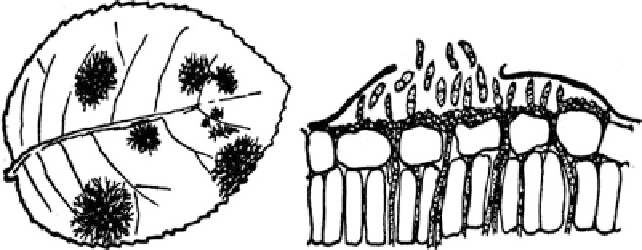Biology Reference
In-Depth Information
In susceptible varieties the appearance of
black spots is soon followed by yellowing of
a portion or all of leaflets and then by defoliation.
The leaf fall is apparently correlated with
increased production of ethylene gas in diseased
tissue and perhaps by a difference in auxin gradi-
ent between leaf and stem. Some roses lose
almost all their leaves, put out another set and
lose those, and often are trying to leaf out for the
third time by late summer. The process is so
devitalizing that some bushes may die during
the following winter. On tolerant varieties leaf
spots are present, though usually in smaller
numbers, but there is much less yellowing and
defoliation. Cane lesions are small
black areas, slightly blistered, without fimbriate
margins.
Infection
occurs through either leaf surface,
the fungus sending its germ tube directly through
the cuticle by mechanical pressure. The hyphae
form a network under the cuticle, joining together
into several parallel filaments radiating from the
point of infection. The hyphae are actually color-
less, the black color of the spot coming from the
death and disorganization of host cells. The
mycelial growth is between cells, with haustoria
(suckers) invading epidermal and palisade cells
for nourishment.
Acervuli, summer fruiting bodies, formed just
under the cuticle, bear two-celled hyaline conidia
on short conidiophores on a thin, basal stroma.
Splashed by rain or overhead watering, or spread
by gardeners working among wet plants, the
conidia germinate and enter a leaf if there is
continued moisture for at least 6 h. Rain, heavy
dew, fog, and sprinklers used late in the day so
foliage does not dry off before night provide the
requisite moisture. New spots show up within
a week and new spores within 10 days. Secondary
cycles are repeated all summer - from late May to
late October around New York City.
In my personal experience, the spread of disease
is most rapid where large numbers of susceptible
varieties are massed together. If all the yellows, for
instance, are planted together, the disease gets such
a head start, and builds up so much inoculum to
spread to the more tolerant red and pink varieties
nearby, that these varieties also are more heavily
infected than usual. When roses are mixed in beds
so that one or two particularly susceptible bushes
are surrounded by more resistant types, the infec-
tive material cannot increase so rapidly, and the net
indistinct
Fig. 1
Rose Blackspot. Note fimbriate margin to spot
Fig. 2
Rose Blackspot.
Two-celled conidia formed
in Acervulus under cuticle



